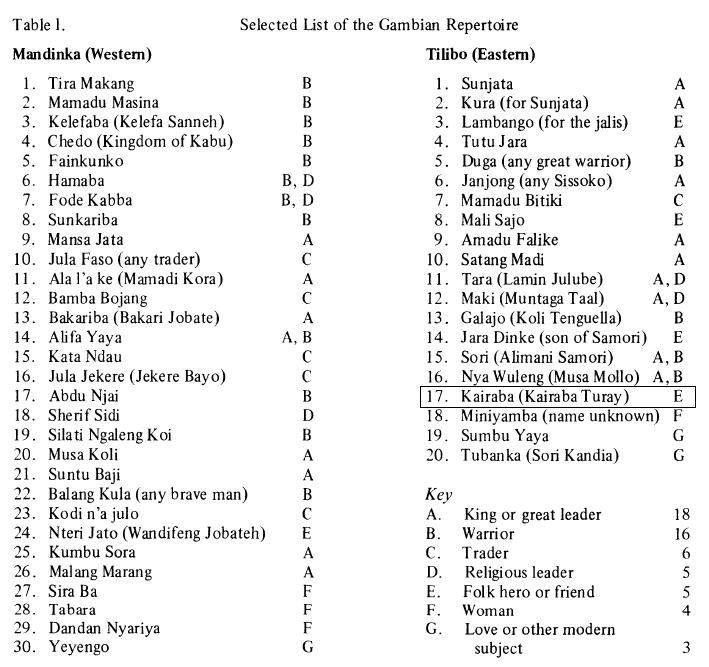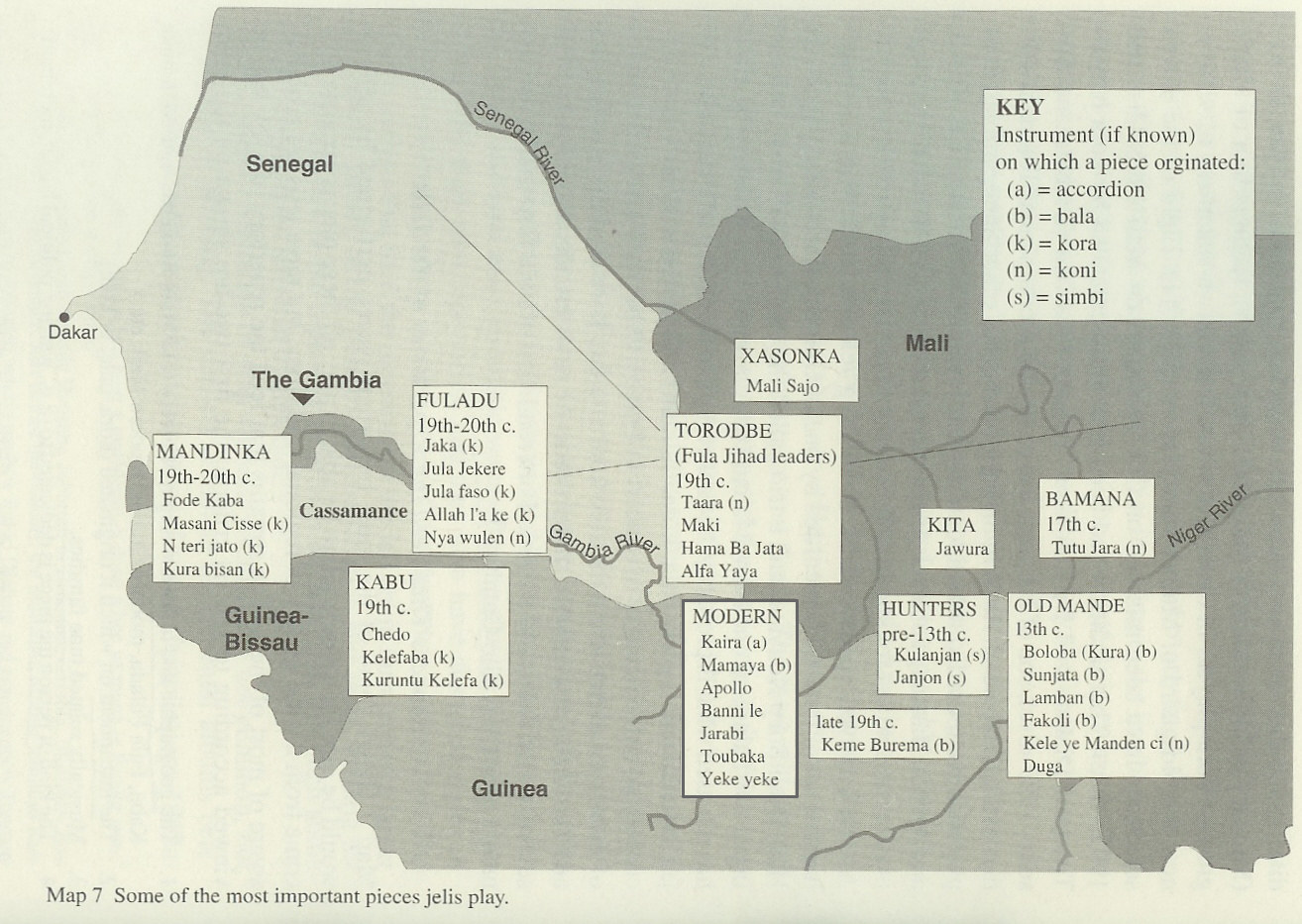kaira
Ministère de l'information du Mali. 1971. Première anthologie de la musique malienne: 1. Le Mali des steppes et des savannes: Les Mandingues. Barenreiter Musicaphon, BM 30L 2501.
(Kayra)
This song is not a classic; it is not dedicated to anybody. Yet it is of sociological value. Written at Kela in 1946, it worked against the jazz wave imported from the West. Kayra means luck; and around this song young people's associations have formed in all countries of the steppes and savannas. In the beginning Kayra was considered a sort of juvenile delinquency, but slowly the young people’s associations ripened to become an effective support for the RDA (Rassemblement Démocratique Africain = African Democratic Movement).
Knight, Roderic. 1982a. "Manding/Fula Relations as Reflected in the Manding Song Repertoire." African Music 6 (2): 37–47.
(Kairaba)
p. 39
Table One . . . includes the best known, most often heard, or otherwise significant songs in the [Gambian] repertoire. In each column the top few songs are the oldest, and the bottom few are the youngest. The majority in each case fall somewhere in between (often in the nineteenth century), but no chronological ordering beyond this is intended, since it is often not possible to date a song exactly. Most of the songs bear the name of their owner as the title. Where they do not, his name is shown in parentheses next to the title. The letter code at the right represents the person's "claim to fame" or calling in life, as shown in the bottom of the list.

p. 40
Table Two shows the same fifty songs again, grouped this time by the ethnic background of the people commemorated.

Jessup, Lynne. 1983. The Mandinka Balafon: An Introduction with Notation for Teaching. La Mesa, Calif.: Xylo.
(Kaira / Kairaba)
pp. 146–59 (Appendix 2: Balafon Repertoire)
| Title | Kaira |
| Translation: | Happiness |
| Dedication: | Kaira Touray |
| Notes: | same as Kairaba |
| Calling in Life: | Trader |
| Original Instrument: | Balafon |
| Region of Origin: | Manding (Western Coastal Region) |
| Date of Origin: | L (after WWII) |
| Sources: |
| Title | Kairaba |
| Translation: | Great happiness |
| Dedication: | Kairaba Touray |
| Notes: | |
| Calling in Life: | Folk hero, friend |
| Original Instrument: | Balafon |
| Region of Origin: | Tilibo |
| Date of Origin: | L (after WWII) |
| Sources: | 3 (R. Knight 1973) |
Konte, Lamine. 1975. La kora: Les rythmes, les percussions et la voix de Lamine Konté. Vol. 2. Arion, ARN 33313.
(Kairaba)
Musique de balafon; Air malinké; Hymne au bonheur.
Sissoko, Djelimoussa "Ballake." 1997. Jeli Moussa Sissoko: Kora Music from Mali. Bibi B. Bucking Musikverlag/Nbg., 9764-2 Indigo.
(Kaira)
During the 1940s and 1950s, when the movement for independence from French colonial rule gained momentum, the name Kaira was adopted by the association of young griots in the Malian town of Kita. The dances organised by the association provided a venue for young lovers and also expressed nationalist sentiments. Consequently, they were forbidden by the French authorities. Rumor has it that the association was repressed because its members 'stole' the girlfriends of the French commander. After independence Kaira became one of the most popular hits sung by griottes. Nowadays Kaira is often played in F major, however Jeli Moussa's version is in B major following the original composition from Kita.
Rouget, Gilbert, prod. 1999. Guinée: Musique des Malinké. Le Chant du Monde/Harmonia Mundi, CNR 2741112. Reissue of all Guinean material from 1954 and 1972 with expanded notes.
(Kaira Bari)
p. 9
« Kayra Bari », louanges de El Hadj Fall Kaba
p. 10
Cette pièce m'a été donnée par les musiciens eux-mêmes comme étant (je reprends ici les termes de B. Kourouma, qui était mon interprète) « la chanson de Kayra Bari, roi du Fouta », mais « adaptée pour Alahadji (lisez: El Hadj) Fall Kaba », lequel était le « petit frère » de Karamoko Talibi, organisateur de la séance cité ci-dessus dans notre introduction. Selon Youssouf T. Cissé1, Bari est un nom peul et Kayra (ou Khayra1), qui m'a été traduit à Kankan par « Béni des dieux », est effectivement le nom d'un ancien roi peul du Fouta Djalon (région montagneuse bien connue de Guinée). De son côté Lynne Jessup, dans son livre The Mandinka Balafon (1983 : 150), donne « Kaira »2 (traduit « happiness ») comme étant une pièce appartenant au répertoire du balafon et de composition tardive (« late »), c'est-à-dire datant de ces « quarante dernières années »3. Selon, ici encore, Youssouf T. Cissé4, cette pièce appartient en réalité au vieux fonds musical malinké, mais n'a été popularisé dans tout le pays que dans les années 40-60, ce qui rejoint, en définitive, l'observation de L. Jessup5.
Charry, Eric. 2000. Mande Music: Traditional and Modern Music of the Maninka and Mandinka of Western Africa. Chicago; London: University of Chicago Press.
(Kaira)
p. 148

p. 156
Kaira, Arabic for "peace" and also a male first name, is very popular in Guinea and Mali and is often used as a standard musical accompaniment for creating new songs. Kora player Sidiki Diabate (Ministry of Information of Mali 1971-disc, vol. 5/Musiques du Mali 1995b-disc) has done much to develop the piece, and his son Toumani Diabate (1988b-disc) has continued that tradition. According to Sidiki Diabate (1990-per: 455–72), Kaira was originally composed on the accordion by Gese Kemo Diabate in Guinea for a Fulbe interpreter named Kaira Barry in Kissidougou, at a time when there were few motor vehicles (perhaps in the 1940s or earlier). Gese Kemo's son Gese Mamady played it on the guitar, the instrument on which it may have disseminated. By 1949 it was widespread; Arthur Alberts (1949-disc) recorded versions of it by Sira Mory Diabate of Kela, the Kankan Diabates, and an unidentified guitar and kora group possibly from Siguiri (Alberts 1950-disc/1954a-disc).91
91. Notes to Ministry of Information of Mali (l971-disc: vol. 5; reprinted in Musiques du Mali 1995b-disc) state that the piece Kaira was born in Kela in 1946 and became a symbol of a Malian youth movement associated with the pan-West African political party RDA. Perhaps Kaira was composed earlier than 1946, but it gained popularity when the Kela jelis took it up. Djimo Kouyate (personal communication 1997) identified the composer of Kaira as Mecanicien Kemo, probably a reference to the same Gese Kemo, who may have been a bicycle mechanic.
p. 248
The earliest written source specifically indicating that Mande music was being played on the guitar may be Fodeba Keita's (1948) Chansons du Dioliba, a twenty- to twenty-five-minute play consisting of one actor rendering Keita's poetry accompanied by a guitarist. Keita, most likely inspired by his relationship with Facelli Kante, named a dozen pieces of music (such as Kaira and Nanfulen) to be played throughout the performance.
p. 250
Older pieces from the jeli's repertory were rare on commercial recordings before the 1960s.13 Among the several twentieth-century jeli pieces recorded were Kaira, Yarabi (Diarabi), and Mamaya (also known as Bandian Sidime), all three recorded by both "Soba" Manfila Kante (1961?-disc) and Nouhoum Djallo (Nourrit and Pruitt 1978, 1:49–50).
p. 286
Most of the twentieth-century pieces that have entered the repertories of jelis and orchestras come from upper Guinea. Kaira (see chapter 3) and Tubaka are among the most popular musical accompaniments used in both Mali and Guinea and continue to inspire Mande musicians.
p. 321
Sauta is the only kora tuning I know where two varieties of a single pitch class, the natural and sharp fourth degree, may be present (but in different octaves). Sidiki Diabate indicates that the sharp fourth degree is the norm for Sauta, but the piece Kaira sounds better if one of the strings is lowered to become a natural fourth degree.
EC: You said that Sauta is also a song [donkilo], a piece [julo]. Is it the name of a piece [julo]?
SD: Sauta is a tuning [kumbengo].
EC: A tuning [kumbengo]?
SD: Yes, it is a tuning [kumbengo], many pieces [julu] can be played in it. Allah l'a ke is good in it. Kaira also, Kaira is good in it, but there is a place that is not played in it. If you want to play Kaira in Sauta you have to lower this string. (S. Diabate 1990-per:41)25
pp. 398–401 (Appendix C: Recordings of Traditional and Modern Pieces in Mande Repertories)
Modern: Kaira
Arthur Alberts (1954a)
Diabate Brothers of Kankan (Rouget [1954a] 1999)
"Soba" Manfila Kante (1961?, vol. 3)
Baila et Ses Balladins (1967)
Orchestre de la Garde Républicaine (1967)
Sidiki Diabate and Batrou Sekou Kouyate ([Ministry of Information of Mali 1971, vol. 1] Musiques du Mali 1995b)
Rail Band (1975, HNLX 5148)
Kandia Kouyate (Tono, 1988)
Ami Koita (Ami Kaira, 199?)
Kasse Mady Diabate (1990)
Mansour Seck (Kairaba, Elimane Boubacar Kane, 1994)
Aboubacar Camara (Deri, 199?)
Rail Band (Dounia, 1995)
Moriba Koita (1997)
Toumani Diabate with Ballake Sissoko (1999)
Diabate, Toumani. 2001. Jarabi: The Best of Toumani Diabate; Master of the Kora. Hannibal, HNCD 1462.
(Kita Kaira)
"Kita Kaira" is a version of the classic tune "Kaira" (which means "peace"), which was first made famous by Toumani's father Sidiki in the 1940s during the last decades of colonial rule in Mali. It became a rallying point for Malians, a form of cultural protest against colonial values. This new version was created by Toumani in the style of Kita, a town in north-west Mali from which both his and Ballake's family originally came, before migrating first to Gambia (at the turn of the century) and then back to Mali after the Second World War. Kita was the centre of a powerful kingdom at the time of Sunjata Keita, founder of the Mali empire in 1235, and has always been famous for its musicians and its beautiful melodies.
Bangoura, Mohamed "Bangouraké." 2006. Mandeng Jeli.
(Keirabah)
From the Mandeng region of Guinea.
"Keirabah" means peace. This rhythm is the daily rhythm for the griot of Mandeng in this rhythm the griot sings about life of the Mandeng people, everything has its moment and time.